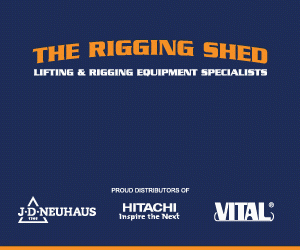)
Space surveillance telescope uses Konecranes for installation and maintenance
A new $97.2 million Australian Space Surveillance Project based in Exmouth, Western Australia, has been fitted with two Konecranes CXT double-girder underslung cranes. The cranes have lifting capacities of 15 and 20t respectively to receive and install materials on the new space surveillance telescope.
The first of their type, the telescopes and supporting facilities are designed to increase the capacity to detect and track objects in space to manage threats, including space debris, and predict and avoid potential collisions.
Including the 270t rotating dome, telescope and buildings, the project is being built for the Australian Defence Force by managing contractor Sitzler, and is on track to meet initial operating capability in 2021.
The CXTs had to be suspended from the ceiling due to limited space in the building. One of the cranes had to be able to remain locked in position as the dome rotates so it could still perform all its usual functions at whichever angle the building is facing. The section of the building where the crane was attached is capable of rotating up to 17deg per second, with rate of rotation varying according to the telescope’s particular usage.
Konecranes’ project manager Claudia Estrada says, “The cranes needed to meet tight space requirements and utilising underslung cranes – which are typically involved in one in every hundred projects – provided better hook approaches to suit the client’s lifting requirements.”
The cranes both featured Konecranes’ Extended Speed Range (ESR) smart feature, which meant they had a variable speed drive for additional precision and control when lifting expensive, delicate components.
“ESR was particularly valuable for this project, because the telescope’s powerful mirrors, which are the key to its functionality, are highly valuable items. If one mirror becomes damaged during installation, it’s a very expensive and highly specialised part to replace,” says Estrada.
Paul Gurr, project manager at Sitzler, says that Konecranes was selected because the manufacturer’s cranes met all the complex specifications required for this important project.
He says, “In addition to the ESR and other functionality specifications, there were extra safety requirements for locking of the crane while rotating, and Konecranes was able to meet the stringent requirements.
“Konecranes is a world leader in safety and the brand is known for its quality, reliable products. These qualities, plus their ability to meet all the customised needs of this project, were major factors in the decision to recommend Konecranes as the overhead crane equipment and service provider.
“Right from the beginning, Konecranes was thorough with detailing and reporting, which helped us with the smooth and efficient management of the project, and ensured we remained on schedule,” says Gurr.
The construction of the telescope building and support facilities has now been completed, and preparations have begun for the telescope to be installed, calibrated, tested and evaluated.
Chief of Air Force, Air Marshal Leo Davies says, “Air Force is working with Australian industry and educational institutions to build domestic space surveillance capability for Australia. [The facilities] represent a significant achievement by Defence and Australian industry to enable the capability to be realised.”









